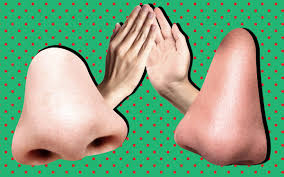Have you ever met someone and known right away you’d found a new friend? Was it their smile, their laugh, a twinkle in their eye or maybe a clever joke they told?
In truth, the deciding factor might have been an underappreciated item on your subconscious checklist. As is the case for many mammals, your instant bond may have developed right after the first sniff.
Whether we notice it or not, we are constantly probing our surroundings with our smell radar just like rodents and nonhuman primates. Mice and chimps seem to have the scent awareness to know immediately who to befriend and who to rebuff. And though we might think of ourselves as apart from our warm-blooded relatives, new research shows that us hairless humans may not be so different after all.
Yes, we gravitate toward a smile or people we have something in common with, such as age, personality, and even physical appearance, but it seems we might also secretly seek out those who smell like us. Inbal Ravreby, a neuroscientist at the Weizmann Institute of Science in Rehovot, Israel, got her inspiration for an experiment to test out this idea after she started to contemplate the phrase “There is chemistry between us.” Sure, Ravreby reasoned, it could just be another figure of speech. Some phrases are just phrases, after all, but sometimes we have phrases because people notice a phenomenon. It felt to her like something worth checking out….
 Ravreby and her research team did just that by employing a chemical sensing device called an electronic nose, along with a collection of human “smellers” to back up its measurements. Their work — published in Science Advances — found that friends who “clicked” when they first met smelled more alike than random pairs of people, suggesting our nose might play a part in how we know who we’ll get along with best.
Ravreby and her research team did just that by employing a chemical sensing device called an electronic nose, along with a collection of human “smellers” to back up its measurements. Their work — published in Science Advances — found that friends who “clicked” when they first met smelled more alike than random pairs of people, suggesting our nose might play a part in how we know who we’ll get along with best.
For the experiment, the researchers gathered 20 pairs of same-sex friends who reported clicking during their first encounter with each other. For three days, participants gave up scented soaps, garlic and anything else that might alter their body odour, and each wore a cotton T-shirt to bed to capture their scent.
 The stinky shirts were handed over to the electronic nose, which used an array of sensors to measure the chemical difference in the body odours of the members of each pair. The researchers found that twosomes who clicked with each other when they met had more similar scents, compared with randomly selected pairs of other people in the study.
The stinky shirts were handed over to the electronic nose, which used an array of sensors to measure the chemical difference in the body odours of the members of each pair. The researchers found that twosomes who clicked with each other when they met had more similar scents, compared with randomly selected pairs of other people in the study.
To compare the electronic nose to what humans actually detect, a team of designated smellers also tested scent similarity. When sniffing body odour samples, the human smellers ranked each scent in “intensity,” “pleasantness” and another three categories. Overall, the pairs of fast friends had more similar smell rankings than the coupled strangers. The human smell squad also reported that “click friends”—when sniffed side by side—had more similar body odours than strangers, showing that the closeness in these smells was present in how people perceived them, not just the chemistry detected by the electronic nose.
 Scent similarity was even able to successfully predict which pairs of complete strangers would get along 71 percent of the time. After also embedding their odour into T-shirts for aroma analysis, the pairs of strangers were placed half a metre apart to play a game where they tried to mimic each other’s movements and then asked how they felt about their partner. Players who reported clicking with their game partners had more similar body odour chemistry, additional evidence that such odour plays a role in how humans identify prospective pals.
Scent similarity was even able to successfully predict which pairs of complete strangers would get along 71 percent of the time. After also embedding their odour into T-shirts for aroma analysis, the pairs of strangers were placed half a metre apart to play a game where they tried to mimic each other’s movements and then asked how they felt about their partner. Players who reported clicking with their game partners had more similar body odour chemistry, additional evidence that such odour plays a role in how humans identify prospective pals.
Moving forward, Ravreby wants to delve deeper into the mechanisms behind our subconscious social sniffing. She plans to measure how brain activity responds when a person smells a body odour that reminds them of themselves versus an aroma that’s very different. Her theory is that humans constantly sniff themselves to establish a baseline scent to compare with the odours of everyone around them and that this might play a role in how we subconsciously tell friend from foe.
REFERENCES:
Inbal Ravreby, Kobi Snitz and Noam Sobel. There is chemistry in social chemistry. SCIENCE ADVANCES, 24 Jun 2022, Vol 8, Issue 25.
https://www.science.org/doi/10.1126/sciadv.abn0154
